INTRODUCTION
Sheep and goats are most productive when fed a balanced ration according to their nutrient needs. The needed nutrients should also be supplied at lowest possible cost. This can be done if producers use locally available feed ingredients and use purchased feeds only to fill the gap in nutrient supply from the locally available feeds. If the producer has more than one type of feed as a source of a nutrient (e.g. protein source), it is good to prioritize the available feeds based on their relative suitability and whether they are the most economical sources of the desired nutrients. Goats are an important source of meat and milk (Devendra and Burns, 1983). Recently, goats became an important aspect of animal production in Egypt. A large number of rural households raise goats with a herd size varying from 3 to 5 heads. These herds represent more than 90% of total goat population in Egypt. Therefore increasing productivity of goats will contribute to improve the standard of living of the rural people. Ruminants have unique ability to utilize the fibrous material through anaerobic fermentation (Kibria et al., 1991), therefore, cottonseed cakes (CSC) are being traditionally used as a feed for dairy animals. However, limited supply and seasonal availability of CSC result in high price. On the other hand, sunflower meal (SFM) is cheaper protein source and can be used as ruminants feed supplement (Yunuset al., 2004). Earlier investigations (Garcia et al., 2004) indicated that sunflower meal was equally good in performance, yet the cost of sunflower meal based rations was the lowest. Therefore, the present study was conducted to evaluate the effect of replacing concentrate feed mixture containing cotton seed cake by 15 or 20% of whole sunflower seeds on growth erformance, puberty and reproductive characteristics of male and female offsprings of Zaraibi goats.
MATERIALS AND METHODS
This research is the second part of a serial number of studies on Zaraibi goats (an Egyptian breed) fed a basal ration consisting of 25% concentrate feed mixture (CFM) beside 75% fresh berseem (FB, clover, Trifolium alexandrinum) during winter feeding or 50% CFM and 50% berseem hay (BH) during summer feeding. The CFM consisted of cotton seed cake, linseed cake, yellow corn, wheat bran, molasses, calcium chloride and common salt. Goats of all groups were given the NRC feeding requirements (NRC, 2001) for production of 1-2 kg milk/head/day. The daily feed intake per doe composed of 1.250 kg CFM at 8.00 a.m. + 4 kg green berseem or 1.3 kg BH twice daily (11 a.m. and 3 p.m.). At the late stage of pregnancy (last month of pregnancy, all experimental does (n=30) were divided into three experimental groups according to their age, weight and milk production. Goats in the 1st group (G1) served as a control group and were fed the basal ration (control). However, does in the 2nd (G2) and 3rd (G3) groups were fed the control ration, but 15 and 20% of CFM was replaced by whole sunflower seeds, respectively.
After parturition, kids were allowed to suckle their dams up to reach a minimum age of 8-10 weeks and a minimum body weight of 11- 12 kg when they have been weaned. Newborn male and female kids produced from each experimental group were kept at the same feeding system of their dams. Kids were fed according to the NRC (2001) allowances on CFM and FB during winter feeding and CFM and BH during summer feeding. The amounts of CFM were adjusted according to the changes of body weight. All kids were kept under the same managemental conditions in a semi- open shaded yard during the experimental period. After weaning, 18 buck kids (6 from each dam group) with an average live body weight of 16.03+0.39 kg and 18 doe kids (6 from each dam group) with an average live body weight of 15.1+0.49 kg were fed the same dam rations to study their effects on productive and reproductive performance. Feedstuffs were offered in two almost equal meals at 8.0 am and 4.0 p.m. All kids were weighed at birth and thereafter biweekly intervals till the end of the experiment.
Buck kids in all groups were subjected to observation to detect changes in sexual behavior, once at 10 day intervals during the period from 3 months of age up to the onset of puberty (first successful ejaculate with motile sperm). To ensure the availability of at least two does in estrus at each time of libido test, five does were subjected to estrus synchronization by intramuscular injection of 25 mg progesterone (Lutone, Misr Co., for Pharm Ind. SAA, Cairo) for five successive days followed by a signal injection of 5 mg estradiol benzonate (Folone, Misr Co, for Pharm Ind. SAA, Cairo) 24 hours after the last progesterone injection. Treated does were subjected to estrus detection 24-48 hours after last hormonal injection using intact buck. Treatment for estrus synchronization was planned at a time suitable for the time of libido test. Age, weight, scrotal circumference and testosterone concentration were determined at 1st mounting, mounting with erection (1st penile protrusion) and puberty.
Scrotal circumference was measured and recorded once every two weeks from 4 up to 9 months of age according to Hahn et al. (1969). Scrotal circumference was measured for each buck kid by a flexible plastic tape around the greatest diameter of the tested and scrotum. After the occurrence of puberty or the stage at which male ejaculated first sperm, semen was collected by means of an artificial vagina. Before semen collection, buck kids were sexually stimulated by allowing two false mounting followed by 5 minutes restrain. The following physical semen characteristics were evaluated in fresh collected semen:
- Seminal volume was measured directly in milliliter to the nearest 0.1 ml using a graduated collecting tube.
- Initial motility was determined directly after collection in a drop of fresh raw semen microscopically examined at 200 x magnification. During examination the temperature was held at 37 oC by means of a stage warmer attached to the microscope. Initial gross motility of raw semen (without extension) was estimated on a percentage score basis as described by Melrose and Laing (1970).
- Percentage of live/dead spermatozoa was estimated by testing one hundred sperm cells stained by eosin: nigrosin stain.
- Percentage of abnormal spermatozoa was determined in the same smears prepared for live/dead sperm test. Two hundred spermatozoa were counted in each smear for abnormal sperm count.
- Sperm cell concentration (x 109/ml) was counted microscopically using Neubauer Haemocytometer.
Blood samples were taken biweekly from 5 buck kids of each group starting at 4 months of age till puberty for testosterone determination in blood serum. Puberty was determined by attained mounting, errection and 1st ejaculation. Testosterone was determined with a radioimmunoassay (RIA) method, described by Stupnicki(1982). The sensitivity of the assay was 0.6 ng/ml, and the intra- and inter-assay variation coefficients were 12.4 and 14.6%, respectively.
Age at puberty was recorded when doe kids exhibited its first estrous behavior. At 4 months of age, teaser bucks were introduced to the doe kids to detect the onset of the 1st estrus, twice daily at 7 a.m. and 4 p.m. for 20 minutes each. Doe kids being receptive for teaser and standing for mounting by the teaser were considered in estrus. The onset of first estrus was used as an indicator for the onset of puberty.
Laparoscopy (Wolf /8933 / 7 mm-made in U.S.A.with W., Germany) was used to visualize the ovarian structure changes after the 1st estrus for determined CL and follicular counts. The CL and ovarian follicles were determined by the aid of scales on the stainless-steal rode used for the genital tract manipulation. The laparoscopy examinations were performed on fastened animals (16 hours before examination) (McKelvey et al., 1985).
Blood samples were taken biweekly from 5 doe kids of each group starting at 4 months of age till puberty (1st estrus cycle). Quantitative determination of P4 in blood serum was carried out using progesterone radioimmunoassay kit (Catalog No. 1188 manufactured by Immunotech, France). The assay is based on competition reaction (Bojanic et al.,1991). Samples were incubated 1 h with I125 labeled progesterone, as tracer, in antibody-coated tube. After incubation the liquid contents of the tubes are aspirated and bound radioactivity is measured to determine progesterone in serum using automatic Mini-Gama counter (LKB 1275,USA). The sensitivity of the progesterone assay is 0.03 ng/ml, while coefficient of variation is 4.3% for both progesterone intra- and inter-assay, respectively.
Data obtained in this study were subjected to statistical analysis using General Linear Models Procedures (GLMP) adapted by SPSS for windows (2004) for user’s guide. Duncan test of SPSS programme was done to determine the degree of significance between the means at P<0.05.
RESULTS AND DISCUSSION
Growth performance of kids:
Live body weight during suckling period:
At birth:
Live body weights and number or percentage of kids (males and females, single, twins, triplets and quartets) at birth as affected by feeding their dams on different experimental rations during pre-partum period are presented in Table 1. Results show that feeding does on 20% SFS ration yielded the highest total number of kids with the lowest average LBW/kid, while the control does or those fed 15% SFS ration showed an opposite trend. Such findings are in relation with litter size. It is of interest to note that feeding 15% SFS ration resulted in some change in sex ratio of produced kids, where this group produced greater males than females and sex ratio was 64.3: 35.7 male: female versus 41.4: 58.6 in control and 52.9: 47.1 in those fed 20% SFS ration. Also, LBW of female kids only of does fed 20% SFS was significantly (P<0.05) lower than in the control group. Generally, LBW of males was higher than that of females in all groups.
Table 1: Effect of feeding on the experimental rations on live body weight (kg, mean ± SE), number and percentage of borns at birth.
Concerning the prolificacy of does, feeding 15 and 20% SFS rations yielded the highest frequency distribution of triplets (42.85 and 52.94%, respectively) versus the distribution of twins (62.06%) in the control group, but with significantly (P<0.05) lighter weights than in both treatment groups. Also, feeding 15 and 20% SFS rations yielded quartets with in significant heavier weights in 20 than in 15% SFS group, while none of does in the control group produced quartets (Table 1).
At weaning:
Live body weight, number or percentage of single, twins, triplets and quartets and viability rate of kids at weaning as affected by milk intake and feeding the same experimental rations during the suckling period are presented in Table 2. Results show average LBW, litter weight and viability rate of kids, since LBW and / or viability rate at weaning were higher for twins and triplets higher in 15 and 20% SFS groups than in the control group, but the differences were not significant.
Table 2: Effect of feeding experimental diets on live body weight (kg, mean ± SE) of borns at weaning.

However, LBW was higher and viability was lower for quartets in 20 than in 15% SFS groups, but the differences were also not significant (Table 2). The difference in birth weight of kids may be attributed to the effect of parity of dams. The birth weight of the kids is also influenced by the nutrition the dam received during the pregnancy term (Otuma and Osakwe, 2008). This was reflected in increasing LBW and litter size of kids in 15 and 20% SFS groups. The nutrition effect was obvious by Toteda et al. (2004), who pointed that lambs born to ewes offered fish oil had higher (P<0.05) birth weight than lambs born to ewes fed diet without fish oil. This is may be due to the improvement of feed utilization during late-pregnancy period. Accordingly, Schinckel and Short (1991) found that ewes with lower intake produced lambs with less of body weight by 34% than those from ewes with higher intake during pregnancy period.
This variability in growth performance may be partially due to higher intake (energy) of does during lactation period. Sibbald and Davidson (1998) reported that ewes with lower intake during lactation would reduce the live weight gains of their lambs. Also, Hayder (1996) reported that heavier lambs at birth were capable of drawing more milk. Abd El-Rehim (1997) found that level of intake during gestation and lactation was shown to have a significant effect on lamb birth weight and subsequently growth rate. On the other hand, Gargouri (1997) showed that although milk fatty acids have a high digestibility in young lambs, the average daily gain at weaning is correlated more with the protein content of milk than with its energy content. Overall birth weight as obtained in the present study indicated that the single born kids were heavier than the twins, the triplets and the quarter. The results are in agreement with the findings of Inkulov et al. (2009) for German Fawn goats, Kamal (2008) for Sudanese Nubian goats; Ershaduzzaman et al. (2007) for Black Bengal goat, Delgadillo et al. (2007) in goats from Mexico, and Afzal et al. (2004) for Aradi goats of Saudi Arabia. In agreement with the present results, several authors reported that males are heavier than females at birth and at all the times (Naik et al., 1985) in kids of Ganjam breed of goat.
Live body weight post weaning:
Live body weight of kids during post-weaning period as affected by feeding the same experimental rations are presented in Table 3. Results show that kids of treatment groups fed 15 or 20% SFS rations were heavier than those fed the control ration at all ages of post-weaning period, but the differences were not significant, except at 210 days. These results may be due to improving gain and feed utilization with fat which has been related to its energy density. This could be related to the higher value of nutrients digestibility, feeding values and genetic efficiency (Ruvuna et al., 1992). In accordance with the present results, Lough et al. (1993) found marked increase in average daily gain by feeding palm oil to rams. However, Clary et al. (1993) stated that 4% tallow tended to increase average daily gain but the differences were not significant. Also, Marinova et al. (2005) found that addition of fish oil to rations of kids increased average daily gain and feed utilization which have been related to its energy density. The results obtained are in agreement with other studies that have compared linseed with fish oil in sheep (Demirel, 2000). On contrast, Cooper et al. (2004) found no effect of oil supplements on growth performance of cows.
Table 3: Effect of feeding experimental diets on live body weight (kg, mean ± SE) of kids after weaning for treatment groups (12 kids, 6 male and 6 female each).
Reproductive performance of buck kids:
Changes in scrotal circumferences:
Average scrotal circumference of buck kids of does in different experimental groups at different ages is presented in Table 4. Results revealed that scrotal circumference showed gradual increase with advancing age in all experimental groups, being the highest in buck kids of does fed 20% SFS ration at all ages studied, but the differences among the experimental groups were not significant at all ages. The highest rate of increase in scrotal circumference was observed between 150 and 180 days of age in all groups. However, buck kids in 20% SFS group showed further increase than the other groups between 240 and 270 days of age. It is well known that scrotal circumference is one of the most useful measurements of buck’s breeding ability. Research indicates that scrotal circumference is highly related to improved semen quality, quantity, and reproductive success. Bucks with larger testicles also tend to sire that reach puberty at a younger age. Interestingly to note that the changes in scrotal circumferences with advancing age are in association with those in post-weaning LBW, particularly in kids of 20% SFS group. The present trend of increase in scrotal circumferences at all stages is similar to that obtained by El-Saidy (2004).
Table 4: Effect of feeding experimental diets on monthly testicular circumferences (cm, mean ± SE) of buck kids after weaning.
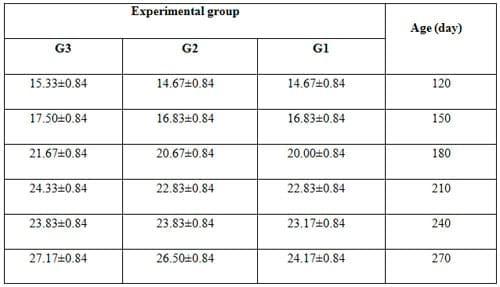
The genetic correlation between scrotal circumference and birth weight appears to be relatively low, whereas the correlation between scrotal circumference and yearling weight is relatively high. This suggests that larger scrotal circumference (earlier puberty) and faster growth rate are compatible in young sires. Selection for increased scrotal circumference resulted in increased growth from birth to yearling ages while holding birth weights relatively constant. These relationships suggest a favorable growth curve, i.e. reaching a higher percentage of mature weight at earlier ages while maintaining or increasing early growth rate and possibly holding mature weight (Brinks, 1990). In bulls, larger testis size had been reported to be correlated with increased mature testicular (Coultler and Keller, 1979) and increased pregnancy rate (Lunstra et al., 1982). If testicular size is to be considered in selection programs, for breed differences, heritabilities and relationships of testicular measurements to age and body weight must be established for young beef sires. Lunstra (1982) indicated that scrotal circumference was a more accurate predictor of when a sire reached the puberty than either age or weight regardless of breed or breed cross.
Changes in testosterone concentration (ng /ml):
Average concentration of testosterone in blood serum of buck kids of different experimental groups is shown in Table 5. Results show that testosterone concentration gradually increased in all experimental groups by advancing age, being significantly (P<0.05) the highest in 20% SFS group, followed by 15% SFS group, while the lowest values were recorded in the control group. It is worthy noting that testosterone concentration showed similar trend of increase with advancing age in the control group. However, in both treatment groups, testosterone concentration showed higher rate of increase with advancing age, being the highest in 20% SFS group, particularly from 210 up to 255 days of age.
Table 5: Effect of feeding experimental diets on biweekly testosterone concentration (ng/ml, mean ± SE) in blood serum of buck kids after weaning.
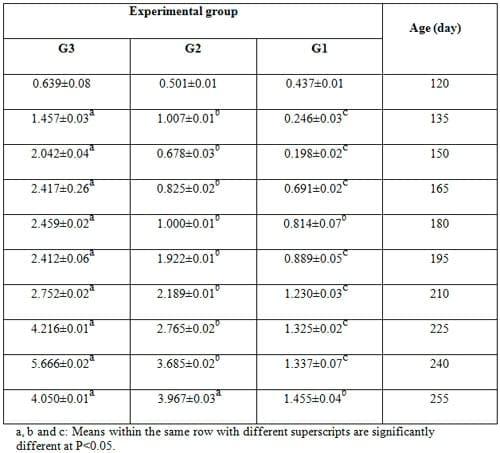
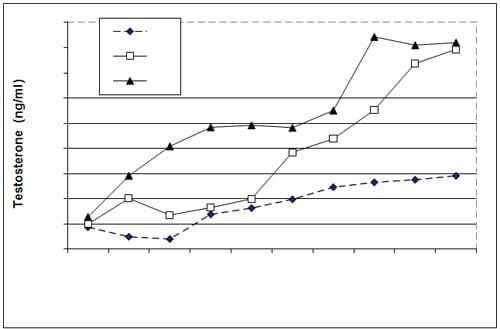
Similar observations were reported by Ali and El-Saidy (2003), who found that the total concentration of testosterone increased steadily with age advantage of ram lambs. The range of testosterone concentrations in blood serum of all groups are similar to that reported by Schanbacher and Crouse (1980) in Suffolk ram lambs, being from 0.4 to 3.4 ng/ml. Mann and Clutwak-Mann (1981) reported that a significant rise in testosterone was observed several weeks before start of ejaculation of semen. Androgens are essential for most stages of spermatogenesis, particularly meiosis maturation of spermatozoa and in the attainment of sexual maturity in male. The concurrent rise in serum testosterone between 5 to 6 months of age was suggested to be due to the release of testosterone at the initiation of puberty and sexual development of the animals. Negative feedback by gonadal steroids including testosterone is known to be an integral component of the hypothalmo- pituitry-gonadal axis in males and serves to modulate the release of gonadotropins by the anterior pituitary gland (D'Occhio et al., 1982).
Characteristics of puberty:
Puberty characteristics of buck kids in different experimental groups including age, LBW, scrotal circumference and testosterone concentration are presented in Table 6. The present results revealed that puberty age was significantly (P<0.05) earlier in 15 and 20% SFS groups by about one month than in the control group. This reduction in puberty age was accompanied with higher LBW and scrotal circumference only in 20% SFS group, but the differences were not significant. However, testosterone was significantly (P<0.05) higher in both treatment groups than in the control one, being the highest in 20% SFS group. Such findings indicated beneficial effects of feeding rations congaing SFS on early puberty incidence in buck kids, in particular that contained 20% SFS. In accordance with results of 20% SFS group, larger testis size in beef bulls have been reported to be correlated with increased sperm output (Blockey,1980), decreased age at puberty (Lunstra et al., 1978), increased mature testicular (Coutler and Keller, 1979) and increased pregnancy rate (Lunstra et al., 1982). The results in the present study indicate that scrotal circumference was related to body weight and age (Madani et al., 2000). Also, the increase nutrients intake was associated with increase in testicular weight (size) and secretory output of accessory sex glands.
In this respect, Walkden-Brown et al. (1994) suggested that testicular mass appears to be primarily dependent on changes in voluntary feed intake and growth. On the other hand, the testicular growth in rams is partly independent on changes in gonadotrophin releasing hormones (GnRH) secretion. However, the testicular growth persists for much longer than those on LH and FSH secretion. So, the gonadal and gonadotropin responses are correlated over time (Hotzel et al., 1997). The effect of nutrition on hormone secretion regulated the testicular growth was studied by several authors. Perez-Claring et al. (1998) concluded that improved nutrition accelerated the testicular growth and a transit increase occurred pulstile secretion of LH.
Table 6: Characteristics (mean ± SE) of puberty of kid bucks in different experimental groups.
Semen characteristics of the 1st ejaculate:
Physical characteristics including volume, percentages of initial motility (%), livability, abnormality of spermatozoa, and sperm concentration of kid bucks in 1st semen ejaculate of buck kids in experimental groups are shown in Table 7. Results show that ejaculate volume, and percentages of initial motility, livability and sperm cell concentration were higher in the 1st ejaculates of buck kids of 15 and 20% SFS groups than those in the control group. However, the differences were significant (P<0.05) only for ejaculate volume, initial motility and sperm cell concentration. Generally, the present results of the 1st ejaculation at puberty are very low and below the normal values of the sexually mature bucks. It is expected that these starting values will increase and reach normally by the advance of age and consequently the complete development of the sex organs. It is believed that any comparison at such early stage might be meaningless due to the quick change in the values of the characters and the variability of body weight among tested groups at puberty. However, the values of first ejaculate in this study were used as a sign to indicate that animals reached puberty age. El-Shamaa (2002) found that semen quality at puberty was low and reach normality by the advance of age and consequently the complete development of the sex organs. Several authors reached to marked improvement in ejaculate volume with age progress (El- Badawy, 2003 and El-Saidy, 2004). Rege et al. (2000) reported a gradual improvement in ejaculate volume, percentages of initial motility, normality and sperm cell concentration of ram lambs by age progress, reaching the maturity at 12 months of age. Kumi-Diaka et al. (1985), found that average of morphological sperm abnormalities at puberty was high; being 25.2% in sub- tropical ram lambs. In accordance with the present results, Drokin et al. (1999) and Roock et al. (2001) found that the ejaculate volume increased (P<0.05) and sperm concentration was improved in rams fed rations with fish oil compared with those fed the control diet.
Table 7: Semen characteristics of 1st ejaculate at puberty in kid bucks of the experimental groups.
Increasing the ejaculate volume of kid bucks fed diet containing 15 or 20% SFS may indicate the beneficial effects of energy source on the accessory sex glands to produce large volume of the seminal plasma and / or attributed to the significantly (P<0.05) increase in testosterone level in blood serum of buck kids at puberty. The accessory glands are functionally controlled by testosterone (Martin et al., 1994). The differences in initial motility percentage among the experimental groups might be attributed to testicular and epididymal development especially during the period of early sexual development (Perez-Claring et al., 1998).
Changes in percent of live sperm were suggested to be due to the continuous development and interaction of testicular tissue and epididymal duct during the early stage of sexual development. The results obtained herein concerning the live sperm percentage are in accordance with the results of Nissen and Kreysel (1983), who found that feeding rams on diets containing fish oil increased significantly (P<0.05) percentage of sperm livability and sperm cell concentration as compared to the control. Decreasing the percentage of sperm abnormality may be due to the development and maturation of testicular tissues and epididymal duct. Also, the increase in testosterone hormone level known to be necessary for normal spermatogenesis is believed to play a part in reducing the percent of abnormal sperm (Mann and Clutwak-Mann, 1981).These results are in agreement with those given by Drokin et al. (1999), who found that addition of fatty acids in diets of rams decreased sperm abnormality percentage than control group. Also, feeding fish oil reduced the proportion of spermatozoa with abnormal morphologies (Roock et al., 2001). In general, changes in the nutrition led to profound responses in testicular size and therefore the rate of production of spermatozoa. These effects are largely due to changes in the size of the semeniferous tubules and in the efficiency of spermatogenesis. The trend of increase in sperm concentration was tended to be quite similar to that of percent motile sperm cells and percentage of live sperm cells discussed before in this study.
Puberty and reproductive performance of doe kids:
Characteristics of puberty:
Average of live body weight at puberty and age at the 1st and 2nd estrus cycle of doe kids produced from does in different experimental groups and fed the same rations of their dams are presented in Table 8. Results show that all doe kids had nearly similar body weight at puberty, being around 22 kg. However, age at puberty (1st estrus incidence) significantly (P<0.05) differed among the experimental groups, being lower for doe kids of group fed 15 and 20% SFS rations than in those in the control group. This means that feeding SFS rations (15 and 20%) to dams and their kids significantly (P<0.05) induced early puberty by about 29 and 26 days as compared to feeding the control ration. Concerning the incidence of the 2nd estrus cycle, also doe kids of group fed SFS rations (15 and 20%) were significantly (P<0.05) earlier in induced the 2nd estrus cycle by about 31 and 29 days as compared to feeding the control ration. This was reflected in significantly (P<0.05) shorter estrus cycle of doe kids in group fed 20% SFS than in the control group. However, estrous cycle length did not differ in group fed 15% SFS ration as compared to those in group fed 20% SFS or the control ration. Such findings may indicate beneficial effects of feeding dams and / or their doe kids on rations containing 15 or 20% SFS on puberty age and estrous activity post-puberty.
Table 8: Live body weight (kg) and age (day) as well as post-pubertal estrous activity of doe kids as affected by the experimental rations (mean ± SE).
Ovarian activity on day-7 post- the 1st estrus:
Laparoscopic examination 7 days post-the 1st estrus in term of number of corpora lutea (CLs) and visual follicles on the ovarian surface on the right and left sides of 3 doe kids in each experimental group is shown in Table 9. Results revealed that number of CLs on the right or left ovaries and as total number/doe kid were significantly (P<0.05) greater on ovarian surface of doe kids in group fed 20% SFS ration than in those fed 15% or control rations. This finding may indicate higher ovarian activity of doe kids in 20% SFS group than in other groups before puberty in term of silent ovulation incidence. On the other hand, number of follicles on the right or left ovaries and as total number / doe kid were significantly (P<0.05) greater in 15 and 20% SFS groups than in the control group, being the greatest in 20% SFS group. Such results may indicate higher post-pubertal ovarian activity when SFS were fed at levels of 15 or 20%. These findings are in association with the early incidence of puberty and estrous activity in normal type for doe kids produced from dams fed 20% SFS ration and fed the same ration post-weaning.
Table 9: Effect of feeding experimental diets on number of corpora lutea (CLs) and follicles on the ovarian surface of three doe kids in each group on Day 7 post the 1st estrus (mean ± SE).
Progesterone (P4) profile:
Plasma progesterone (P4) concentration (ng/ml) in blood serum of doe kids in each experimental group during post- and pre puberty is presented in Table 10. At pre- and post-pubertal days, P4 concentration showed significant (P<0.05) changes with different trends in each experimental group. Concentration of P4 was almost ≤0.5 ng/ml in serum of all doe kids of all groups from 120 up to 180 days of age, indicating no signs of puberty at these ages. On day 195 of age, P4 concentration significantly increased above 1 ng/ml in doe kids of all groups, but reached the maximal values in groups fed 15 (G2) and 20% (G3) SFS rations, being significantly (P<0.05) higher than in the control group. Reaching the 1st P4 peak in G2 and G3 on day 195 of age indicated incidence of puberty (1st estrus) in both groups on day 204 and 206 of age, respectively. This mean that incidence of the 1st estrus in G2 and G3 was about 9 and 11 days after P4 peak in both groups, respectively. However in the control group, P4 peak was significantly (P<0.05) recorded on day 225 of age, and puberty occurred on day 233 of age, about 8 days of P4 peak.The present results regard to puberty age are in agreement with the results of Marinova et al. (2005), who found that addition of fish oil increased feed intake, and subsequently affected body weight of kids.
Table 10: Average of progesterone concentration (ng/ml) in blood serum of doe kids in different experimental groups at different pre- and post-pubertal ages (mean ± SE)

The positive effect of feeding SFS in this study may be mediated through high digestibility of nutrients and improved ruminal fermentation, TDN and energy intake (Jones et al. 2003). Incidence of early puberty in doe kids of group fed SFS, although the differences in LBW at puberty were very small and may be attributed to increasing average daily gain. In this respect, Bathaei and Lerog (1997) reported a significant correlation between body weight at puberty and average daily gain from weaning to puberty. They also revealed that average daily gain and body weight together contributed to 96% of the variation in attaining puberty. Concerning the changes in P4 concentration at different ages as affected by the experimental rations, improvement in reproductive performance may be due to increasing P4 production /secretion favorable to improved fertility (Yoel-Zeron et al., 2002). Also, William and Charles (2003) found that fat addition had positive effect through other physiological mechanism such as P4 concentrations in plasma which enhanced by fat and may also enhance embryo survival; certain fatty acids, such as linoleic acid eicosapentanoic acids may reduce uterine secretion of prostaglandin.
REFERENCES
Abd El-Rehim, S. A. (1997). The reproductive performance of ewes fed rations containing different sources. M. Sc. Thesis, Fac. of Agric., Ain Shams Univ.,Cairo,Egypt.
Afzal, M. ; K. Javed and M. Shafiq (2004). Environmental effects on birth weight in Beetal goat kids.PakistanVeterinary J., 24 (2): 104-06.
Ali, M. F. and B. E. El-Saidy (2003). The effect of feeding dried sugar beet tops on the reproductive and reproductive performance of ram lambs. J. Agric. Sci., Mansoura Univ. 28(8): 5969.
Bathaei, S. S. and P. L. Lerog (1997). Note on age and body weight at puberty in Mehraban Iranian fat-tailed ewe lambs. Trop. Anim. Hlth Prod., 29: 55.
Blockey, M. A. (1980). Getting the most out of rams, bulls and boars. Proc. Aust. Soc. Anim. Prod., pp. 3-46.
Bojanic, S. ; R. Lake ; J. Place ; L. Jones ; J. Laycoock ; G. Carter and J. Alagh-Band-Zadeh (1991). Serum progesterone concentration is raised during early follicular phase in women with polycystic ovaries. Ann. Clin. Biochem., 28: 105-106.
Clary, E. M. ; R. T. Brandt ;D.I.Harman and T. G. Nagaraja (1993). Supplemental fat and ionophores in finishing diets: feed lot performance and ruminal kinetics in steers. J. Anim. Sci., 71: 3115.
Copper, S. L. ; L. A. Sinclair ; R. G. Wilkinson ; K. G. Hallett ; M. Enser and J. D. Wood (2004). Mainipulation of the n-3 polyunsatruated fatty acid content of muscle and adipose tissue in lambs. J. Anim. Sci., 82(5): 1461.
Delgadillo, J. A. ; M. A. De Santiago-Miramontes1 and E. Carrillo (2007). Season of birth modifies puberty in female and male goats raised under subtropical conditions. The Animal Consortium, 1:6, pp 858–864.
Demirel, G. (2000). Dietary Effects on Fatty Acid Composition of Sheep Meat.Ph.D.Diss.BristolUniversity,Bristol,U.K.
Devendra, C. and M. Burns (1983). Goat Production in the Tropics. 2nd ed., CAB.,Edinburgh.
D'Occhio, M. J. ; B. D. Schanbocher and J. E. Kinder (1982). Relationship between serum testosterone concentration and pattern of luteinizing hormone secretion in male sheep. Endocrinology, 110: 1547.
Drokin,S. I.; T. N. Vaisberg ; E. F. Kopeika ; K. D. Miteva and G. L. Pironcheva (1999). Effect of cryopreservation on lipids and some physiological features of spermatozoa from rams pastured in highlands and in valleys. Cytobios: 100(393): 27.
El-Badawy, A. M. M. (2003). Nutritional and physiological studies in ruminants. M. Sc. Thesis, Fac of Agric. Mansoura Univ.
El-Saidy, B. E. I. (2004). Seasonal variations in the reproductive performance of crossbred Finnish rams (Finnish x Rahmani) inEgypt. Alex. J. Agric. Res., 49(1): 11.
El-Shamaa,I.S. (2002). Onset of puberty, semen production and blood constituents in crossbred male lambs as affected by dietary yeast culture addition. J. Agric. Sci. Mansoura Univ. 27(7): 4589.
Ershaduzzaman, M. ; M. M. Rahman ; B. K. Roy andS.A.Chowdhury (2007). Studies on the diseases and mortality pattern of goats under farm conditions and some factors affecting mortality and survival rates in Black Bengal kids.Bangladesh. J. Veterinary Med., 5(1 & 2): 71-76.
Garcia, J.A.; S. P. de F. Vieira; P. R. Cecon; G. M. P. de Melo; A. de S. Martins and M. C. Stti (2004). Apparent digestibility of sunflower meal in growing dairy cattle feeding. Ciencia Anim. Brasileira, 5 (3): 123-129.
Hahn, J. ; R. H. Foote and G. E. Seidel (1969). Quality and freezability of semen from growing and aged dairy bulls. J. Dairy Sci., 52: 1843.
Hayder, M. (1996). Growth performance and some physiological parameters of suckling lambs fed ascorbic acid. M. Sc. Thesis, Fac. of Agric. Assuit. Univ.Assuit,Egypt.
Hotzel, M. J. ; A. Caraty and G. B. Martin (1997). Effects of nutrition on testicular growth in mature Merino rams actively immunized against GnRH. J. Reprod. Fertil. 110(2): 307.
Inkulov, M. ; A. Nebesni ; M. Krajinovi and M. Oujovi (2009). Reproductive traits of German Fawn goats in Vojvodina. Biotech. Anim. Husb., 25 (1-2): 119-124.
Jones, D. F. ; W. P. Weiss and T. C. Jenkins (2003). Dietary fish oil for dairy cows: 2-effects on neutrophil function and digestibility. Res. Rev. Dairy, 163:99.
Kamal E. E. (2008). Various factors affecting birth weight of Sudanese Nubian goat kids. Research J. Agriculture and Biological Sci., 4(6): 700-03.
Kibria, S. S.; M. R. Islam and C. K. Shah (1991). Development of straw based ration for feeding ruminants. Asian-Aust. J. Anim. Sci., 4: 235-240.
Kumi-Diaka, T. K.; V. O. Djang-Fordjiour and D. Ogwu (1985). Effect of different husbandry systems on the reproductive development of postweaning ram lambs under tropical conditions. Therio., 23 (Issue 4 April) : 583.
Lough, D. S. ; M. B. Solomon ; T. S. Rumsey ; S. Kalf and L. L. Slyter (1993). Effects on high-forage diets with added plam oil on performance plasma lipids and carcass characteristics of ram and ewe lambs. J. Anim. Sci., 71: 1171.
Lunstra,D.D.(1982). Testicular development and onset of puberty in beef bulls.USDAMeat Anim.Res.CenterProg. Rep. No. 1.
Lunstra,D.D.; J. J. Ford and S. E. Echternap (1982). Influence of single- sire and multiple-sire natural mating on pregnancy rate of beef heifers. Therio., 18:373.
Madani, M. O. ; M. S. Rohol ; M. T. Zawia and B. A. El-Uwaishi (2000). Puberty and early sexual development in Libyan fat-tailed ram lambs. Appl. Anim. Behav. Sci., 68(3): 199.
Mann, T. and Clutwak-Mann, C. (1981). Testis and testicular semen. In: Male reproductive function and semen. SpringerVeriag,New York, 269.
Marinova, P. ; V. Banskalieva and V. Tzvetkova (2005). Body and carcass composition and meat quality of kids fed fish oil supplemented diet. Options. Méditerranéennes, Series A, 67: 151.
Martin, G. B. ;S. Tjondronegoroand M. A. Blackberry (1994). Effects of nutrition on testicular size and the concentrations of gonadotrophins testosterone and inhibin in plasma of mature male sheep. J. Reprod. Fertl., 101: 121.
McKelvey, W. A. C.; J. J. Robinson; R. P. Aitken and G. Henderson (1985). The evaluation of a laparascopic techniques in ewes. Theriogenology, 24: 519-535.
Melrose, D. R. and J. A. Laing (1970). The Characteristics ofNormalSemen. Chap. 4, Fertility and infertility in the domestic animals. Ed. By J. A. Laing Bailliere Tindalland Gassell, London.
Naik, P.K. ; B.N. Patro and P.K. Mishra (1985). Some factors affecting the body weight at different ages in Ganjam goats. Indian J. Animal Sci., 55: 213-14.
Nissen, H. P. and H. W. Kreysel, (1983). Polyunsaturated fatty acids in relation to sperm motility. Andrologin 1983 May-June 15 (3): 264.
NRC (2001). Nutrient Requirements of Dairy Goats. 7th Rev. ed. National Academy Press,Washington,DC.
Otuma, M. O. andI.I.Osakwe (2008). Estimation of genetic parameters of growth traits in Nigeris Sahelian goats. Research J. Anim. Sci., 2(3): 83-86.
Perez-Claring, R.; J. Bermudez; H. Anderssen and J. Burguena (1998). Influence of nutrition on testicular growth in corriedale rams during spring. Reprod. Nutr. Dev., 38(5): 529.
Rege, J. E. ; F. Toe ; E. Mukosa-Mugerwa; S. Tembely ; D. Anindo ; R. L. Baker and A. Lahlou-Kossi (2000). Reproductive characteristics of Ethiopian hight and sheep. I. Genetic parameters of semen characteristics and their relationship with testicular measurements in ram lambs. Small Rumin. Res., (37): 173.
Roock, J. A. ; C. C. Shao and B. K. Speake (2001). Effects of feeding tuna oil on the lipid composition of pig spermatozoa and in vitro characteristics of semen. Reprod. Feb. 12 (2): 315.
Ruvuna, F. ; J. F. Taylor ; M. Okeyo ; M. Wanyoike and C. Ahuya (1992). Effects of breed and castration on slaughter weight and carcass composition of goats. Small Rumin. Res., 7: 175-183.
Schanbacher, B. D. and J. D. Crouse (1980). Growth and performance of growing Finishing lamb exposed to long or short photoperiods. J. Anim. Sci., 51: 943.
Schinckel, P. G. and B. F. Short (1991). The influence of nutritional level during prenatal and early postnatal life on adult fleece and body characters. Aust. J. Agric. Res., 12: 176.
Sibbald, A. M. and G. C. Davidson (1998). The effect of nutrition during early life on voluntary food intake by lambs between weaning and two years of age. J. Anim. Sci., 66: 697.
SPSS for windows (2004). Statistical Package for Social Science (SPSS). Release 13.0. The Apasche software foundation for windows.
Stupnicki R.K.E. (1982).Direct radioimmunoassay of testosterone in plasma. Endokrinologie, 80 (1): 1-7.
Toteda, F. ; A. M. Facciolongo ; A. Vicenti; L. Melodia and F. Bozzo (2004). Effect of type of suckling and polyunsaturated fatty acid used on lamb production. 1.productive performance and quanti-qualitative characteristics of the carcass. J. Italian Anim. Sci., 3(1): 71.
Walkden-Brown, S. W. ; B. J. Restall ; B. W. Norton ; R. J. Scaramuzzi and G. B. Martin (1994). Effect of nutrition on seasonal pattern’s of LH, FSH and testosterone concentration, testicular mass, sebaceous gland volume and odour in Australian Cashmere goats. J. Reprod. Fertil. 102: 351.
William, W. T. and R. S. Charles (2003). Effects of dietary fat supplementation on reproduction in lactating dairy cows. J. Anim. Sci., 67: 785.
Williams, C. M. (2000). Dietary fatty acids and Human health. Ann. Zootech., 49: 165-180.
Yoel-Zeron, Sklan, D. and A. Amir-Arav (2002). Effect of polyunsaturated fatty acid supplementation on biophysical parameters and chilling seneitivity of ewe oocytes. Molecular Reprod. Dev., 61(2): 271.
Yunus, A. W. ; A. G. Khan; Z. Alam; J. I. Sultan and M. Riaz (2004). Effect of substituting cottonseed meal with sunflower meal in rations for growing buffalo calves. Asian- Aust. J. Anim. Sci., 17: 659-662.


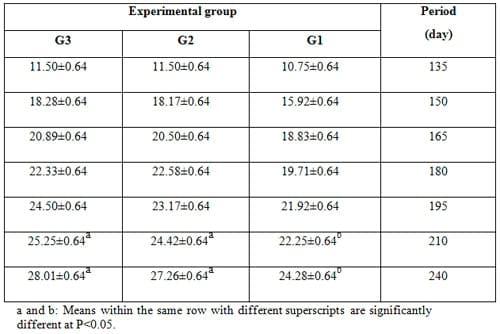




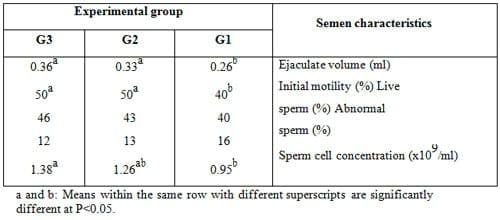
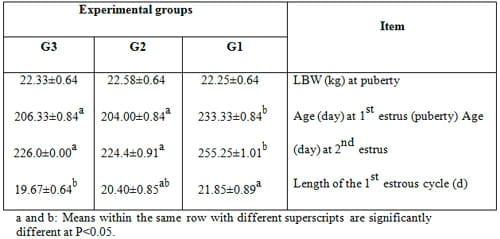
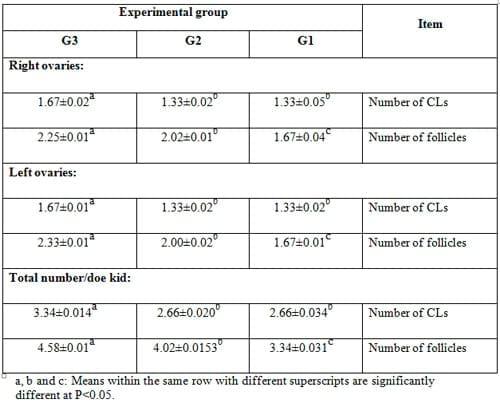








.jpg&w=3840&q=75)